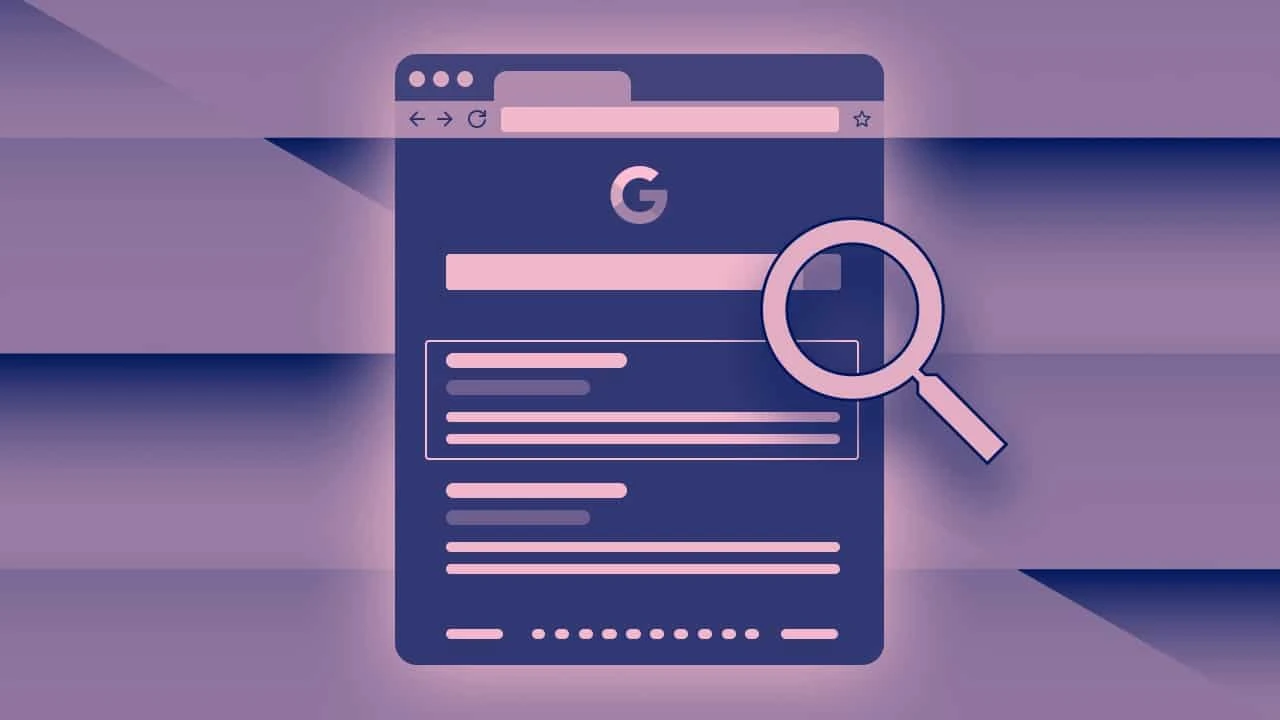If your business relies on inbound traffic from search engines, it pays to keep up with how Google presents results to users.
One easy way you can do this is by optimizing your content to appear in featured snippets in the search results. Featured snippets are quick answers to search queries that appear right at the top of Google’s search results. Here’s an example:
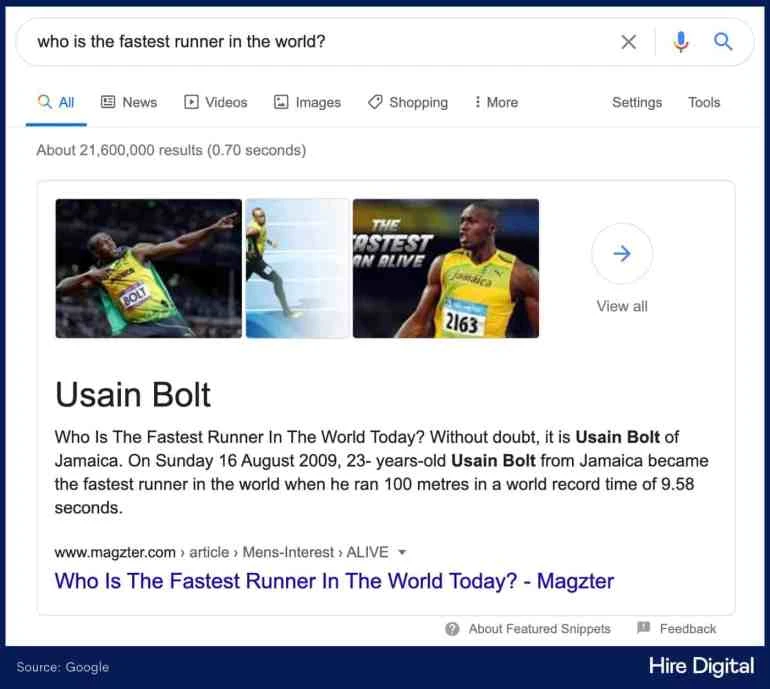
Google’s algorithms create featured snippets using information extracted from web pages that are relevant to the search query. While coding techniques can help you win featured snippets, most of the work is done through writing—so let’s explore why and how to enhance your copywriting to get a featured snippet.
Why target featured snippets?
Featured snippets give you the chance to be in the best possible position in the search results, even if you don’t have the Number 1 organic ranking.
Because of their size and prominence, most users will read the featured snippet before anything else. Some will click through to your site to learn more—and that means more traffic for you.
In addition, featured snippets are closely tied with voice search results. If Google uses your content in a featured snippet, it will usually reference the content when responding to voice queries too.
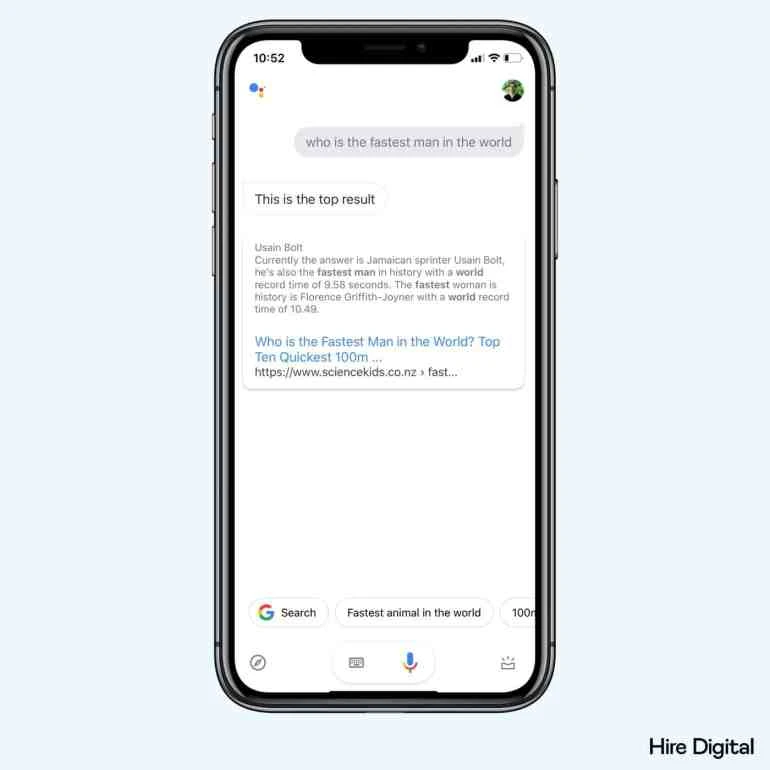
Lastly, even when people don’t visit your site, featured snippets still expose your brand and help you to appear as a thought leader.
Will featured snippets always bring my site more traffic?
In the past, the featured snippet was almost a guaranteed traffic win, because your site would appear twice in the search results – first in the featured snippet, then in the normal listings.
However, in January 2020, Google changed its algorithm so that content in the featured snippet does not appear again on page 1 of the results. This means that if your site is in position 1 or 2 of the search results, you may actually lose traffic by winning the featured snippet.
After the 2020 Google update, you need to be strategic about the featured snippets you target. Answering a question like ‘how many inches are in a foot?’ won’t win you any traffic, because the user gets all the information they need from the featured snippet.
What you can do instead is target featured snippets that start to answer complex questions, such as “what is SEO?” When the question can’t be fully answered in a featured snippet, the user is more likely to visit your site for further information.”
Alternatively, if you’re in position 1 and worried about losing traffic, your web developers can place code into your website that opts your site out of featured snippets.
What types of featured snippet are there?
There are three main types of featured snippets:
-
Paragraph
-
List
-
Table
Paragraph-style featured snippets usually give quick answers to popular questions. Google’s intention here is to answer the question in Google itself, so the user doesn’t need to click through. However, Google does also allow the user to visit the page for further information.
These are the most common type of featured snippets, and they often answer how / when / what / why questions.
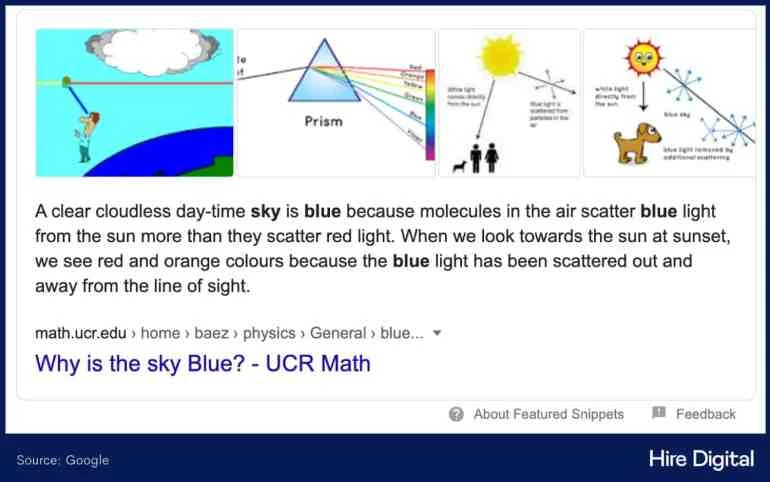
List-style featured snippets often give quick answers to ‘who are the top x’ queries, along with recipes and ‘how to’ content.

Table-style featured snippets often appear in Google when people search for comparisons or numerical information.
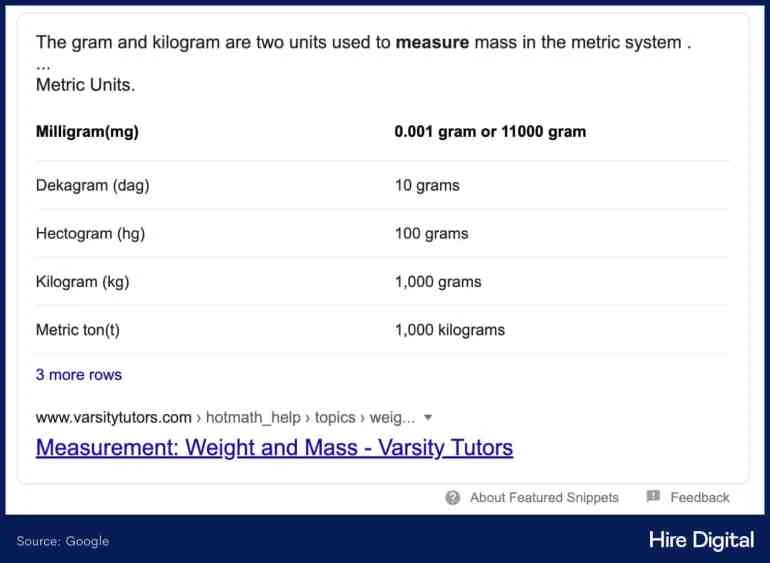
How to get your website content to appear in more featured snippets
-
Find opportunities in your existing content
-
Optimize for featured snippets by improving on your competitors’ content
-
Use a question-and-answer format
-
Keep your answers short
-
Use H tags to ‘bait’ Google into seeing your content as suitable
-
Target featured snippets in your new content
-
Answer questions that haven’t been answered before
-
Include the search query within your answer
1. Find opportunities in your existing content
Most of the time, Google takes featured snippets from websites that appear in the top 10 search results. If you have content that’s already ranking well, you can simply optimise that content to target featured snippets.
If you use Google Search Console (which is free), you’ll be able to see what keywords you are ranking for in the top 10 search results. Put each keyword into Google and see if a featured snippet appears in the results.
[Add an image from Content.co’s search console]
If a featured snippet appears, but it’s from someone else’s site, take note. You may be able to compete and steal the featured snippet just by optimizing your content.
2. Optimize for featured snippets by improving on your competitors’ content
Note what kind of featured snippet currently appears for the keyword you’re targeting—is it a paragraph, table, or list? If you want to win the featured snippet, make sure you’re using the same information format within your content.
You may be able to steal the featured snippet spot by simply creating better content. If your competitor has written a 1,000-word article, make yours a 2,000 word one. If they have listed the top 15 football players of all time, make your list the top 20.
We don’t advocate copying your competitor’s content, but it’s fine to use it for inspiration. Remember, Google favors content that is useful and rich in relevant information, so aim to make your content more in-depth than your competitors’.
3. Use a question-and-answer format
You can further optimize your content by breaking it into chunks in a question-and-answer format. Use a sub-heading like ‘how often should I change my oil?’ Then make sure to answer the question in a separate paragraph directly below.
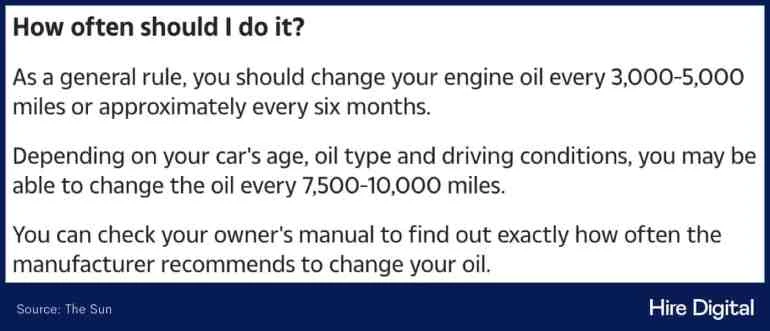
When you’re trying to target a specific featured snippet, it’s also good practice to put the relevant information (whether it’s a list, table, or paragraph) near the top of the page.
4. Keep your answers short
In general, most paragraph-style featured snippets are around 50-60 words long. So when using the question-and-answer format, try to keep your initial answers to around that length. If you need to expand on the answer, do it in a separate paragraph, or as part of a different question.
Keeping your answers short can also help you target voice search queries, as most answers referenced by Google Assistant are 30 words long.
5. Use header tags to get Google to view your content as suitable for featured snippets
Header tags are simple lines of HTML code that indicate when a line of text is meant to be a heading or sub-heading. Google reads these tags to identify when content is being broken into useful chunks, so you can use h tags to get Google to give you the featured snippet.
Use an H2 or H3 tag to turn the questions you ask into sub-headings in your content. This is something you or your website team will do when entering text into your website’s CRM.

If you’re not responsible for uploading content to your company’s website, you don’t need to worry about header tags. Just make sure your text file has clear indications of where text should appear as a sub-heading.
6. Target featured snippets in your new content
It’s probably not worth creating new content solely to win a featured snippet. However, if you’re already putting content out, you can maximize your results by targeting featured snippets.
When you’re creating new content, use a keyword research tool to get suggestions for search queries and related keywords to include. Some tools, like Moz and Ahrefs, will show you which search queries are already generating featured snippets.
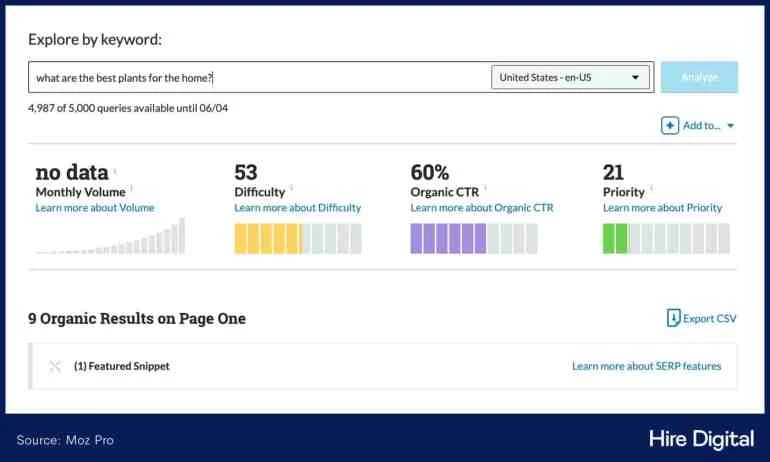
After identifying which search queries generate featured snippets, you can check out your competition and attempt to win the featured snippet by making your content better.
Naturally, when you’re creating new content, make sure you include tables, lists, and question-and-answer sections. Creating ‘how to’ pieces within your content can potentially win you lots of featured snippets.
7. Answer questions that haven’t been answered before
You don’t always have to compete with other companies to win featured snippets. You can also simply be the first site to answer a question that people are searching for.
Sites like keywordtool.io and Answerthepublic.com will allow you to find what people are searching for around a given topic.
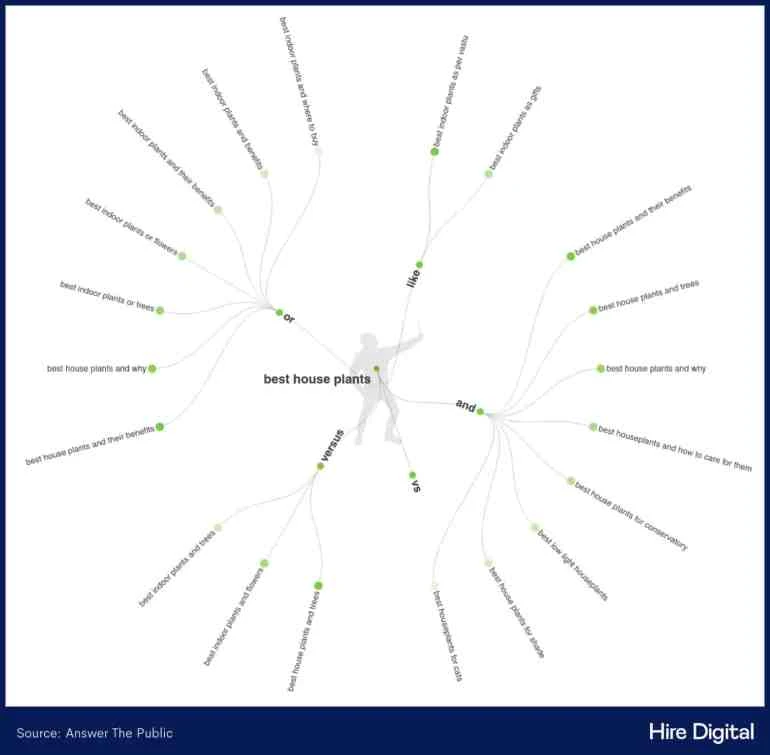
You can then enter the term into Google to see if a featured snippet comes up in the results.
If there’s no featured snippet coming up for the search term, you may be able to get an easy win. Create a list, table, or question and answer section around it in your content, and Google may reward you with a featured snippet.
8. Include the search query within your answer
While we don’t know exactly how Google’s algorithm works, we do know that it looks for content that is highly relevant to search terms. Including the search term and related words in your answer shows Google that the content is more relevant, making it more likely that you’ll win the featured snippet.
Notice how the bold words in this featured snippet all relate to the title.
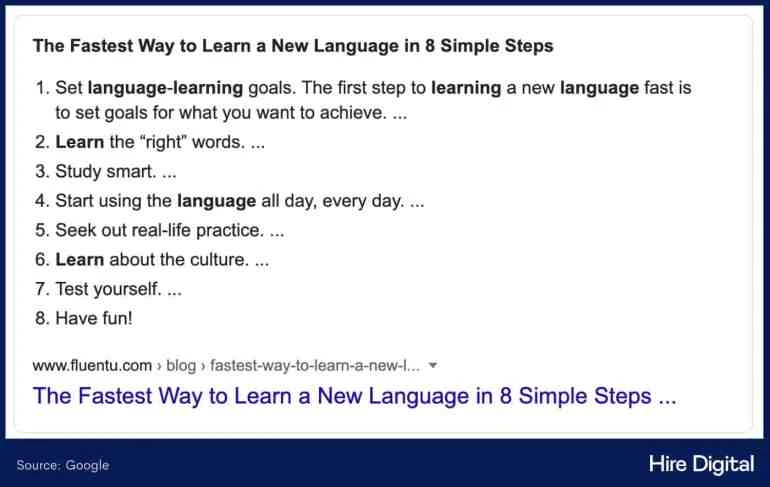
How can you get more people to click your featured snippet and visit your website?
Featured snippets are meant to give people quick and easy answers, so they won’t always click through to learn more.
However, there are some sneaky tactics you can deploy to get more clicks. Firstly, you can offer a free giveaway or template in the title, as Hootsuite has done here:
Second, you can make it so the answer that is displayed in the featured snippet isn’t quite complete. For example, Google usually only shows the first seven items in a list. If your list has more than 7 items, the reader may be tempted to click and see the full list.
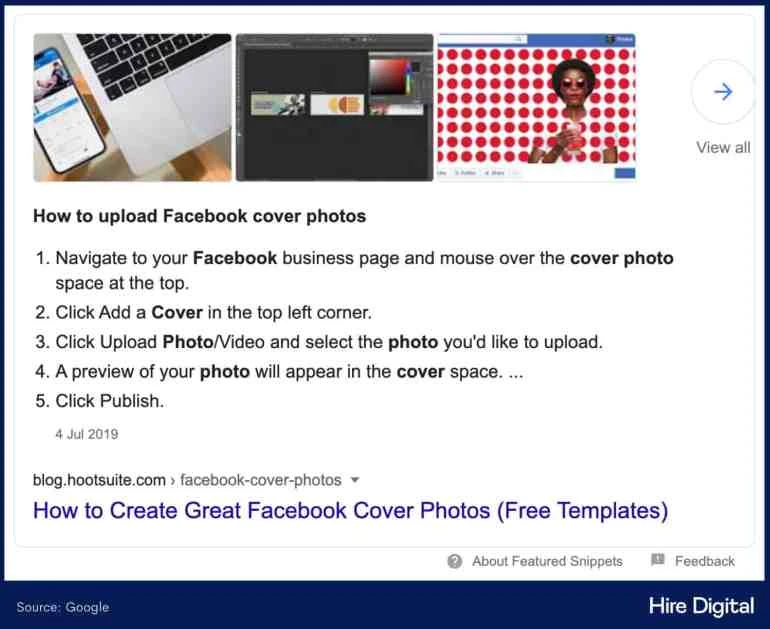
How do I get featured in ‘People also ask’?
Another common feature in search results is the ‘People also ask’ boxes. These are also designed to give the searcher quick answers and are often shown before normal search results.
While these don’t rank as high as featured snippets, they can still bring new traffic to your site. And while the number fluctuates, Moz shows they appear in up to 87% of search results.
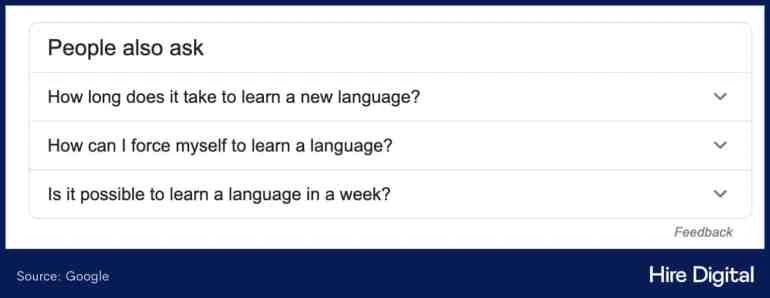
As with featured snippets, we won’t know exactly how Google chooses the sites that will appear in these sections. However, some SEO experts have noted that sites that appear in featured snippets often also appear in People also ask. You can check with an SEO on how you can plan for these featured snippets.
That means you can target them in the same way—with in-depth content, and a question-and-answer content format that responds to common queries.
Conclusion
Although it might seem like a lot of work to win featured snippets, remember that if you’re already putting out content, you’re halfway there. A few simple tweaks, like using header tags and creating ‘how to’ lists, can increase your chances of winning them.
However, the most important part of all this is that you put out useful, in-depth content. Almost all featured snippets are taken from the top 10 search results, so putting out great content and raising your site’s authority will pay off over time.
Google’s algorithms are designed to reward sites that are popular, engaging, and useful—so make sure yours fits that description.
